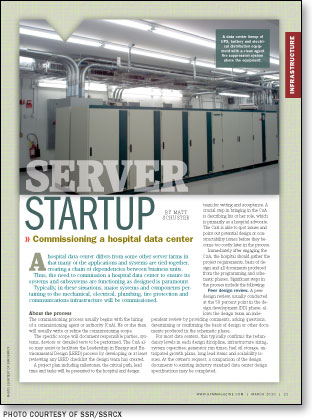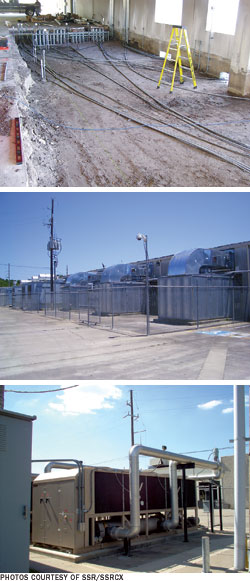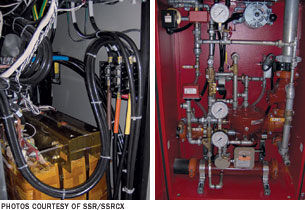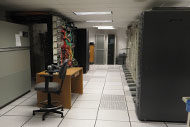 A hospital data center differs from some other server farms in that many of the applications and systems are tied together, creating a chain of dependencies between business units.
A hospital data center differs from some other server farms in that many of the applications and systems are tied together, creating a chain of dependencies between business units.
Thus, the need to commission a hospital data center to ensure its systems and subsystems are functioning as designed is paramount.
Typically, in these situations, major systems and components pertaining to the mechanical, electrical, plumbing, fire protection and communications infrastructure will be commissioned.
About the process
The commissioning process usually begins with the hiring of a commissioning agent or authority (CxA). He or she then will usually write or refine the commissioning scope.
The specific scope will document responsible parties, systems, devices or detailed tests to be performed. The CxA also may assist or facilitate the Leadership in Energy and Environmental Design (LEED) process by developing or at least reviewing any LEED checklist the design team has created.
A project plan including milestones, the critical path, lead time and tasks will be presented to the hospital and design team for vetting and acceptance. A crucial step in bringing in the CxA is describing his or her role, which is primarily as a hospital advocate. The CxA is able to spot issues and point out potential design or constructability issues before they become too costly later in the process.
Immediately after engaging the CxA, the hospital should gather the project requirements, basis of design and all documents produced from the programming and schematic phases. Significant steps in the process include the following:
Peer design review. A peer design review, usually conducted at the 50 percent point in the design development (DD) phase, allows the design team an independent review by providing comments, asking questions, determining or confirming the basis of design or other documents produced in the schematic phase.
For most data centers, this typically confirms the redundancy levels in each design discipline, infrastructure sizing, system capacities, generator run times, fuel oil storage, anticipated growth plans, long lead items and scalability issues. At the owner's request, a comparison of the design documents to existing industry standard data center design specifications may be completed.
In addition, the CxA scope may include cost allowance review or a more detailed cost opinion for independent confirmation.
Fault analysis review. When an existing operational data center is being renovated, careful consideration must be given to any shutdown sequences required.
 |
| Top: Compacted top-soil over a duct bank in preparation for electrical switchgear and a 12,000-gallon fuel tank to be housed inside an explosion-proof room. Middle: A fence and video camera in plain sight deter unauthorized access to this arrangement of three generators in the background and three mechanical air handling units in the foreground. Bottom: A slab-mounted air-cooled chiller supplies chilled water to interior air handling units, while a redundant chiller stands ready in the background. |
A fault analysis review may be prudent though typically not included in a standard scope of work. The fault analysis will examine current mechanical and electrical services generally for primary and secondary active paths to highlight any single point of failure.
There may be nothing worse than the false sense of security from thinking the center has redundancy when, in fact, it doesn't. If renovation work is performed in a data center that hasn't been updated in several years, the equipment may be at a point of capacity or nearing its end-of-life expectancy.
Testing should be scheduled for transfer switches, uninterruptible power supply (UPS) systems, battery cabinets and power distribution units as well as any excess capacity mechanical systems. This will identify existing or potential issues prior to actual renovation work being completed and when the schedule will not be impacted.
Most facility and data center managers will agree that knowing now rather than later is a better position than being unprepared and without contingency plans.
Demolition plan review. For renovations in an operational data center, a specific review of the demolition plans may be completed. Identification of any services and infrastructure is absolutely critical. The hospital will be asked to collect all records and as-built drawings for the entire site and/or campus. This means someone on the team must sort through the mountains of drawings the hospital is storing. Without such drawings, additional costs or time may be incurred.
Constructability review. The constructability review, usually conducted at the 75 percent point in the construction documents (CD) phase, addresses more specific issues than are covered in the design review.
Because the documents have progressed nearly to 100 percent, the constructability review may highlight code-related issues, equipment clearances, construction timeline conflicts and coordination issues.
If no contractor has been engaged in preconstruction services or as another independent review, the CxA may create alternate logs or recommend value engineering items for consideration.
Submittal review. The submittal review process is normally carried out by the architecture and engineering (A/E) team and the hospital typically is not involved. The CxA will require a copy of the submittal for their own review. The submittal contains all the equipment data. Should the equipment not meet the specifications, the A/E team will reject a submittal requesting an action and ask for a resubmit.
Prefunctional checklists (PFC). Many of the previous steps in the commissioning process are optional and may vary with the project's requirements and parameters. The PFC is an absolute requirement in the commissioning process.
The primary purpose of each checklist is to validate that the installed unit is within the specified design parameters per the drawings and specifications. All pertinent unit data is included as well as any relevant information lifted from the project specifications and drawings.
For example, for a computer room air conditioner (CRAC), a manufacturer will provide stand, duct collar, insulation, valve types, pipe type and sizing, drain pans with float switches, humidifier specifications, motor size, cubic feet per minute specifications and chilled water temperatures (if applicable).
Additionally, cosmetic inspection is performed to document any damage during transit or installation. Building automation systems and controls are listed for each device, which will be referenced in the functional performance tests. Each PFC line item should note the reference source, the item description and a status denoting compliance.
The hospital may elect to witness some of the PFC walkthroughs, though some devices may take two hours, depending on the device type and checklist length.
Functional performance tests (FPTs). FPTs provide operational testing of the devices. Any operating parameter data is recorded such as temperature, setpoint alarms and conditions, voltages, amperage and flow rates, depending on the device being tested.
 |
| Left: The interior of a power distribution unit with an isolation transformer. Right: The inside of a preaction water-based sprinkler system cabinet, which is most often combined with a clean agent fire suppression system. |
The FPT will call for a specific mode or condition, the required test procedure and the expected resulting condition with the corresponding compliance status.
For example; an FPT for a chilled water CRAC, operating at temperature setpoint parameters with alarm temperature and relative humidity setpoints, will call for each alarm condition to be triggered by raising or lowering the temperature and relative humidity and noting the unit's response. Furthermore, the building automation system may be simultaneously observed by another CxA to verify the proper event was recorded. Other events will be observed such as smoke detection, duct sensors, float switches, dirty filter alarms and voltage imbalances.
The hospital should understand the scope and extent of the testing procedures. For example, the FPT of a clean agent fire protection system will typically not include an agent discharge. Alternatively, the agent may be replaced with an inert gas or the discharge relay's voltage may be measured to verify proper control wiring and signaling. Noncompliant items will require remediation and may require a secondary FPT to the satisfaction of the CxA and hospital.
Simulations and energy analysis. Over the past few years, interest in computational fluid dynamic (CFD) studies and energy analysis has increased exponentially. Though there are several opposing views on the accuracy of CFD studies, energy analysis has been around for a while and is only now becoming more popular with the "green" movement.
Like all simulations, the output is only as good as the input. CFD studies can run anywhere from $2,500 to more than $100,000, depending on the accuracy, amount of information input, number of simulations and whether post-occupancy real-time measurements are included. The key information required will be the electrical load for each large component, at least at an equipment cabinet level.
Most hospitals do not have the electrical load for each server to be installed in the data center. Developing equipment cabinet profiles with average and maximum loads with their intended installation location is required for analysis. The anticipated growth over the next few years will assist with capacity planning.
The energy analysis can assist in estimating the operational monthly electrical costs. The analysis also may carry a number of recommendations such as reduced lighting loads, increased use of outside air, alternative energy storage and systems or changes to the building location.
Post-construction site visits. The post-construction phase may include post-occupancy, operational phases, opposing season follow-up, opposing season functional performance and post-warranty phases.
These visits should be determined prior to the commissioning start and well-defined in the commissioning scope of work. Depending on the owner's requirements and project's location, an opposing season may not be warranted—data centers located in Buffalo, N.Y., and San Diego would have different opposing season requirements.
Operational data logs and maintenance service records for each device will be useful to the CxA. Any operating data from the building automation system that captures periodic snapshot data will assist the review. The data center manager, whether he or she reports to the facilities or the information technology department, should maintain a journal noting planned and unplanned downtime events.
Involvement is key
Though most data center outages are caused by human events, lack of knowledge about the installed equipment often is a contributing factor.
The health facilities professional who demands involvement throughout the commissioning process and maintains his or her staff's training will have a positive organizational impact.
Matt Schuster is senior consultant of data center services at Smith Seckman Reid Inc.'s Tampa, Fla., office. He can be reached at mschuster@ssr-inc.com.
| Sidebar - Key functions of data centers |
| While data center applications may vary by hospital, many health care facilities will classify or categorize their functions in just a handful of categories to define the affected business units. Such a shortlist would include the following: • Financial. These accounting-related applications may feature a variety of insurance and claims systems and back-office financial reporting systems. They include accounting, business decision support, check imaging and invoicing, claims processing, fundraising and constituent relationship management, supply chain, and time and attendance. • Clinical. The heart of most major health care facilities includes perhaps hundreds of clinical applications. Depending on the institution, they may include biomedical and physiological monitoring, clinical coding and charting, clinical device alarm management, electronic health and medical records, emergency management services, infant protection systems, nurse call and code blue systems, operating room management, patient administration, personal and asset tracking systems, pharmacy management, radiology and picture archiving communications system management, surgery, on-call scheduling systems and trauma registry. • Enterprise. Perhaps the catchall of the categories, these applications usually span more than one category and impact the entire organization. They include contractor management, document management, e-mail, enterprise decision management, human resource management software, interface and message management, performance appraisal systems and registration management. • Facility and information technology infrastructure. These diverse applications are typically invisible to any patient though they provide the foundation for all other applications. When relocating a data center, these will likely be the first applications to be installed in the new location. They include access control, building automation and management systems, domain controllers, electronic video surveillance, file and print servers, Internet and intranet portals, information technology security firewalls, wireless systems, operating systems and patch management, public address, paging and emergency radio systems, and telephone, fax, private branch exchange and voice over Internet protocol communication systems. |
| Sidebar - Commissioning deliverable |
| A data center commissioning project will vary according to the size and type of health care facility being served. In general, though, the following deliverables can be expected at the end of the process: Commissioning scope. The scope defines the roles of each team member, provides contact information, single point of contact, disciplines, equipment list, deliverables and meetings to participate in. It includes project phases and scope. Commissioning plan. This is typically a project plan format that includes critical milestones, project timelines, responsibilities and the associated tasks by phase. Constructability review. The constructability review is in log form, typically listed by discipline, sheet/drawing or specification division and section. Design review (DR). The DR output includes commentary information by discipline, sheet/drawing number, suggested changes or clarifications, submission and review dates, status and general notes or comments. A list of qualifications and assumptions may be included within the DR comments or attached separately. Functional performance test (FPT). A FPT is created for each component in the commissioning scope. These tests verify and validate that the operational parameters, controls and alarms are within the manufacturer's specifications and that they meet any requirements of the hospital. Leadership in Energy and Environmental Design (LEED) registered checklist. The commissioning agent or authority (CxA) may create or review the LEED registered project checklist to assist in determining the project's potential for meeting certification levels. The CxA may also comment on which credits are more readily attainable given the project's requirements, budget and location. Master deficiency list (MDL). The MDL may be considered the primary commissioning project deliverable. It lists all deficiencies by an item, equipment identification or serial number; review date noted on a prefunctional checklist or FPT; deficiency description; the responsible party; any actions taken; and the verified correction date. Prefunctional checklist. A prefunctional checklist is created for each component listed in the commissioning scope. The checklist is used to validate that the installed unit is within the specified design parameters per the drawings and specifications. System/device specific reports. Various systems and devices may require specific configuration and testing by the contractor or manufacturer to validate the equipment for owner acceptance and to initiate the warranty period. These reports are typically generated by the installer with a computer connected to the device. The CxA may witness the device configuration or review the reports to validate the configuration. |




